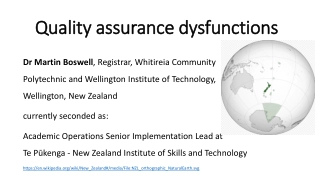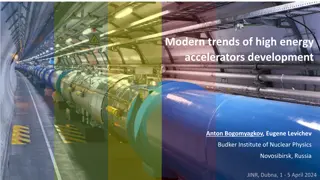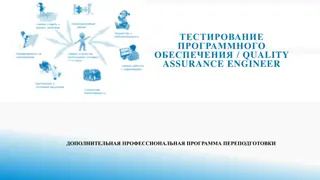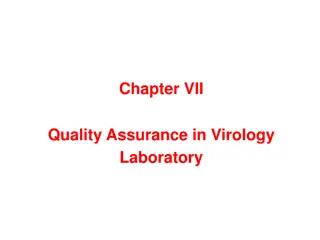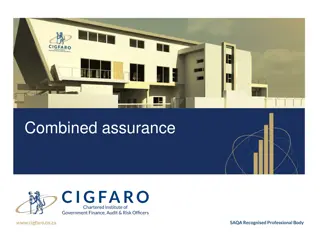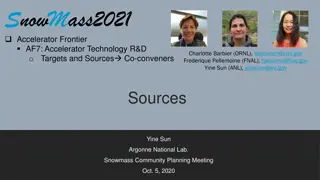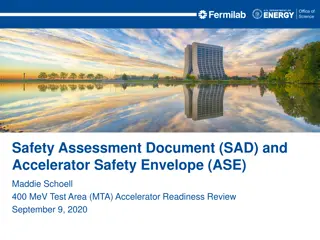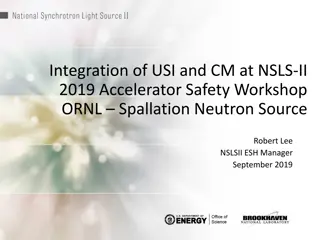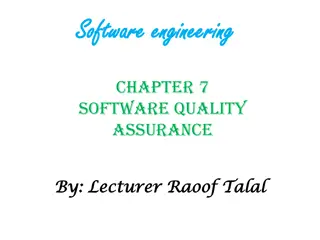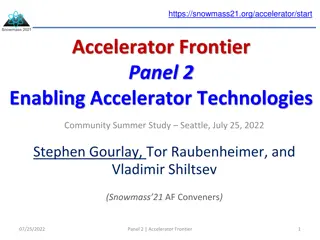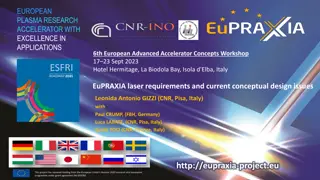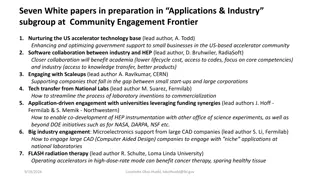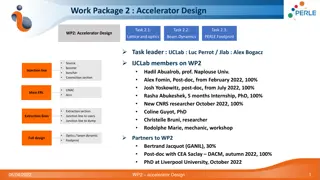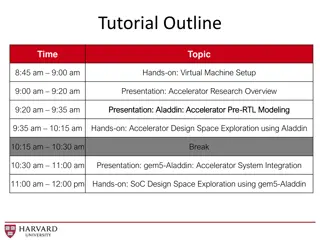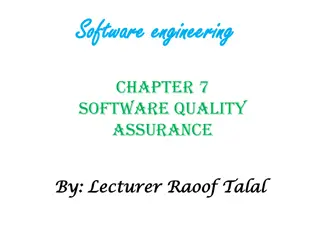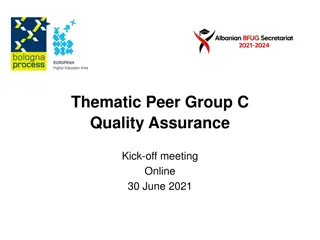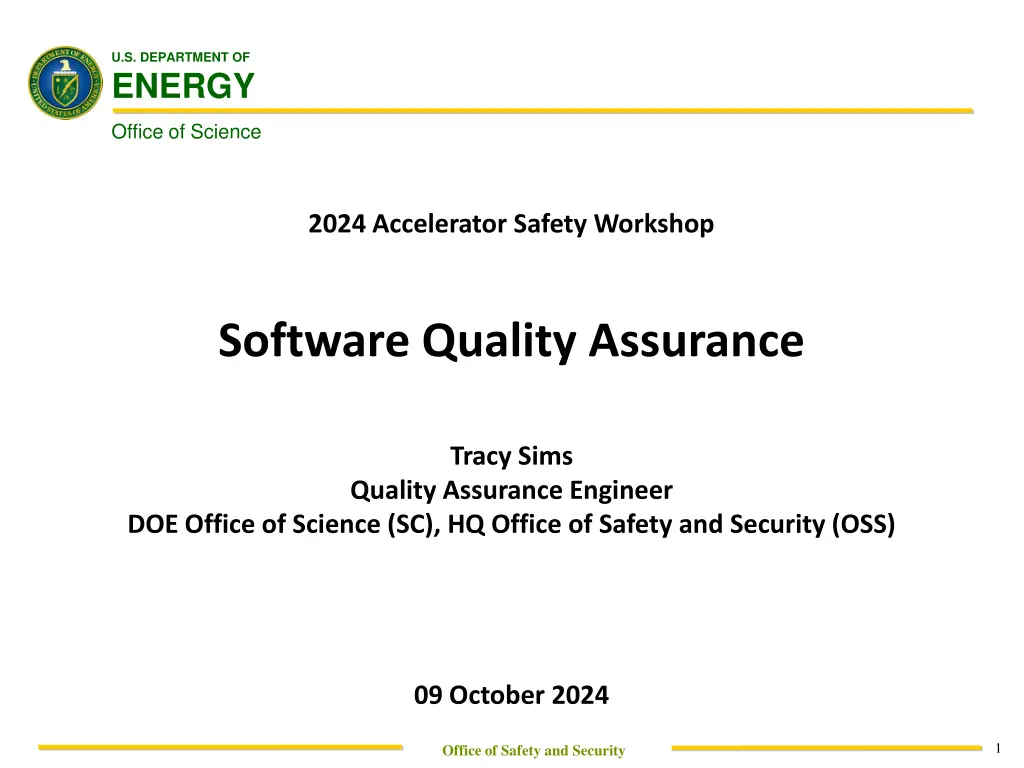
Software Quality Assurance in DOE Nuclear Facilities
Learn about the quality assurance directives, standards, and requirements for software used in DOE nuclear facilities. Explore the safety software quality assurance guidelines, attachment details, and software work activities outlined by the U.S. Department of Energy Office of Science.
Uploaded on | 0 Views
Download Presentation

Please find below an Image/Link to download the presentation.
The content on the website is provided AS IS for your information and personal use only. It may not be sold, licensed, or shared on other websites without obtaining consent from the author. If you encounter any issues during the download, it is possible that the publisher has removed the file from their server.
You are allowed to download the files provided on this website for personal or commercial use, subject to the condition that they are used lawfully. All files are the property of their respective owners.
The content on the website is provided AS IS for your information and personal use only. It may not be sold, licensed, or shared on other websites without obtaining consent from the author.
E N D
Presentation Transcript
U.S. DEPARTMENT OF ENERGY Office of Science 2024 Accelerator Safety Workshop Software Quality Assurance Tracy Sims Quality Assurance Engineer DOE Office of Science (SC), HQ Office of Safety and Security (OSS) 09 October 2024 Oak Ridge Office Office of Safety and Security 1
Quality Assurance Directives U.S. DEPARTMENT OF ENERGY Office of Science Orders and Guides DOE O 414.1D, Quality Assurance DOE G 414.1-1C, Management and Independent Assessments Guide DOE G 414.1-2B, Quality Assurance Program Guide DOE G 414.1-4, Safety Software Guide for Use with 10 CFR830, Subpart A, and DOE O 414.1D Quality Assurance Technical Standards for Software DOE STD-1150-2013, Quality Assurance Functional Area Quality Standard DOE STD-1172, Safety Software Quality Assurance Functional Area Quality Standard Related 10 Code of Federal Regulations (CFR) 830, Subpart A DOE O 226.1B, Implementation of Department of Energy Oversight Policy Oak Ridge Office Office of Safety and Security 2
SQA facts U.S. DEPARTMENT OF ENERGY Office of Science DOE O 414.1D Definition: Software is computer programs and associated documentation and data pertaining to the operation of a computer system. Software is kind of a mystery. It is the hardest part of QA for people to understand because it is not a physical thing per se and there is Software (SQA) and Safety Software (SSQA). ALL Software is considered an item, just like any other physical thing, so it must comply with all ten of the requirements (called Criteria) in Attachment 2 of the DOE O 414.1D Quality Assurance order (we discussed these requirements in the previous QA presentation) Oak Ridge Office Office of Safety and Security 3
Attachment 4 DOE Nuclear Facilities U.S. DEPARTMENT OF ENERGY Office of Science DOE O 414.1D, Attachment 4 contains additional requirements for safety software that is used in nuclear facilities that are categorized as follows: Oak Ridge Office Office of Safety and Security 4
Safety Software Quality Assurance U.S. DEPARTMENT OF ENERGY Office of Science And here is the initial text for Safety Software in Attachment 4. Purpose a. Prescribe the safety software quality assurance (SSQA) requirements for DOE nuclear facilities. b. Software, other than safety software as defined in this Order, is not subject to requirements in this Attachment (4) Using the consensus standard selected and the grading levels established and approved above, select and implement applicable SSQA work activities Oak Ridge Office Office of Safety and Security 5
Attachment 4 SW Work Activities U.S. DEPARTMENT OF ENERGY Office of Science Attachment 4 presents the ten Software Work Activities 1. Software project management and quality planning. 2. Software risk management. 3. Software configuration management (SCM). 4. Procurement and supplier management. 5. Software requirements identification and management. 6. Software design and implementation. 7. Software safety. 8. Validation and Verification (V&V see next slide). 9. Problem reporting and corrective action. 10. Training of personnel in the design, development, use, and evaluation of safety software. Oak Ridge Office Office of Safety and Security 6
Attachment 4 Safety Software U.S. DEPARTMENT OF ENERGY Office of Science The V&V process and related documentation for software are defined and maintained to ensure that: 1. the software correctly performs all its intended functions, and that 2. the software does not perform any adverse unintended function. V&V is the largest area within the SQA work activities. Verification is performed throughout the life-cycle of the safety software (the software produces reasonable results for a representative sample of inputs or test cases,) Validation activities are performed at the end of the software development or acquisition processes to ensure the software meets the intended requirements (the software does what it is supposed to do). Oak Ridge Office Office of Safety and Security 7
U.S. DEPARTMENT OF ENERGY Office of Science SSQA work activities (d) Procurement and supplier management (e) Software requirements identification and management (f) Software design and implementation (g) Software safety analysis and safety design methods (h) Software verification and validation (i) Problem reporting and corrective action (j) Training of personnel in the design, development, use, and evaluation of safety software Oak Ridge Office Office of Safety and Security 8
DOE G 414.1-4 SSW Category U.S. DEPARTMENT OF ENERGY Office of Science Safety Software includes safety system software, safety and hazard analysis software and design software, and safety management and administrative control software. Safety system software (SSS) is software for a nuclear facility that performs a safety function as part of an SSC and is cited in either (1) a DOE approved documented safety analysis or (2) an approved hazard analysis per DOE P 450.4 Safety Management System Policy, dated 10-15-96, and the DEAR clause. Safety and hazard analysis software and design software (SHAD) is software that is used to classify, design, or analyze nuclear facilities. This software is not part of an SSC but helps to ensure the proper accident or hazards analysis of nuclear facilities or an SSC that performs a safety function. Safety management and administrative controls software (SMACS) is software that performs a hazard control function in support of nuclear facility or radiological safety management programs or Technical Safety Requirements or other software that performs a control function necessary to provide adequate protection from nuclear facility or radiological hazards. This software supports eliminating, limiting, or mitigating nuclear hazards to workers, the public, or the environment as addressed in 10 CFR 830, 10 CFR 835, and the DEAR ISMS clause. Oak Ridge Office Office of Safety and Security 9
DOE G 414.1-4 SSW Types p. 1 U.S. DEPARTMENT OF ENERGY Office of Science Custom developed software is built specifically for a DOE application or to support the same function for a related government organization. It may be developed by DOE or one of its management and operating (M&O) contractors or contracted with a qualified software company through the procurement process. Examples of custom developed software includes material inventory and tracking database applications, accident consequence applications, control system applications, and embedded custom developed software that controls a hardware device. Configurable software is commercially available software or firmware that allows the user to modify the structure and functioning of the software in a limited way to suit user needs. An example is software associated with PLCs. Oak Ridge Office Office of Safety and Security 10
DOE G 414.1-4 SSW Types p. 2 U.S. DEPARTMENT OF ENERGY Office of Science Acquired software is generally supplied through basic procurements, two-party agreements, or other contractual arrangements. Acquired software includes commercial off-the- shelf (COTS) software, such as operating systems, database management systems, compilers, software development tools, and commercial calculational software and spreadsheet tools (e.g., Mathsoft s MathCad and Microsoft s Excel). Downloadable software that is available at no cost to the user (referred to as freeware) is also considered acquired software. Firmware is acquired software. Firmware is usually provided by a hardware supplier through the procurement process and cannot be modified after receipt. Oak Ridge Office Office of Safety and Security 11
DOE G 414.1-4 SSW Types p. 3 U.S. DEPARTMENT OF ENERGY Office of Science Utility calculation software typically uses COTS spreadsheet applications as a foundation and user developed algorithms or data structures to create simple software products. The utility calculation software within the scope of this document is used frequently to perform calculations associated with the design of an SSC. Utility software that is used with high frequency may be labeled as custom software and may justify the same safety SQA work activities as custom developed software. With utility calculation software, it is important to recognize the difference between QA of the algorithms, macros, and logic that perform the calculations versus QA of the COTS software itself. Utility calculation software includes the associated data sets, configuration information, and test cases for validation and/or calibration. Oak Ridge Office Office of Safety and Security 12
DOE G 414.1-4 SSW Types p. 4 U.S. DEPARTMENT OF ENERGY Office of Science Commercial design and analysis software is used in conjunction with design and analysis services provided to DOE from a commercial contractor. An example would be where DOE or an M&O contractor contracts for specified design services support. The design service provider uses its independently developed or acquired software without DOE involvement or support. DOE then receives a completed design. Procurement contracts can be enhanced to require that the software used in the design or analysis services meet the requirements in DOE O 414.1C. Oak Ridge Office Office of Safety and Security 13
Safety Software Central Registry Toolbox Codes U.S. DEPARTMENT OF ENERGY Office of Science The Department of Energy (DOE) maintains a list of "toolbox" codes that have been evaluated against DOE Safety Software Quality Assurance (SSQA) requirements of DOE O 414.1D, Quality Assurance and the safety software guidance in DOE G 414.1-4, Safety Software Guide, Appendix B, Procedure for Adding or Revising Software to or Deleting Software from the DOE Safety Software Central Registry and accepted as toolbox codes . The toolbox codes are used by DOE contractors to perform calculations and to develop data used to establish the safety basis for DOE nuclear facilities and their operation, and to support the variety of safety analyses and safety evaluations developed for these facilities. The following is a list of specific versions of toolbox codes that comprise the DOE Safety Software Central Registry. Oak Ridge Office Office of Safety and Security 14
Safety Software Central Registry Toolbox Codes U.S. DEPARTMENT OF ENERGY Office of Science atmospheric dispersion model simulate the impact of past or potential fires and smoke in a specific building environment evaluate the atmospheric release of toxic substances environmental dosimetry computer code safety-analysis of Department of Energy (DOE) facilities handling nuclear material implement the International Commission on Radiological Protection (ICRP) Publications evaluates doses/health risks from accidental atmospheric releases of radio nuclides model the progression of accidents in light water reactor nuclear power plants Oak Ridge Office Office of Safety and Security 15
Safety Software and the DNFSB, the Safety Software Central Registry U.S. DEPARTMENT OF ENERGY Office of Science Since 2002, DOE has struggled to maintain this software registry, leading to the use of outdated software for safety-related calculations. DOE s use of outdated safety software reduces the assurance that calculations provide reliable results. DOE is aware of this challenge and is considering changes to the Central Registry. As part of this effort, DOE solicited and recently received input from the Energy Facility Contractors Group (EFCOG) regarding possible changes to the Central Registry. The Board encourages DOE to make improvements in a timely manner while being mindful of the overall purpose of the Board s Recommendation 2002-1, which is still pertinent. In particular, the Board advises DOE to continue a centralized approach, while enacting changes to make the software registry more sustainable. Many of the codes have updated versions that are being used by DOE s Contractors, and different versions are being used by different Contractors. Oak Ridge Office Office of Safety and Security 16
Safety Software and the DNFSB, the Safety Software Central Registry U.S. DEPARTMENT OF ENERGY Office of Science Defense Nuclear Facilities Safety Board (DNFSB) letter to DOE in 2022 Twenty years ago, the Defense Nuclear Facilities Safety Board (Board) issued Recommendation 2002-1, Quality Assurance for Safety-Related Software. As the Board noted in its Recommendation, DOE and its contractors use many codes to evaluate the consequences of potential accidents. Safety controls and their functional classifications are often based on these evaluations. The robustness and reliability of many structures, systems, and components (SSCs) throughout DOE s defense nuclear complex depend on the quality of the software used to analyze and to guide these decisions, the quality of the software used to design or develop controls, and proficiency in use of the software. As an important part of its response, the Department of Energy (DOE) created the Safety Software Central Registry, which provides enhanced assurance of the quality of commonly used safety software. Oak Ridge Office Office of Safety and Security 17
U.S. DEPARTMENT OF ENERGY Office of Science Any Questions? Quentin Tracy Sims | Quality Assurance Engineer U.S. Department of Energy | Office of Safety and Security (OSS) 9800 S Cass Ave | Lemont, IL 60439 Work Cell: 630-728-8824 | Personal Cell: 708-217-5712 Email: tracy.sims@science.doe.gov Radiological Assistance Program, Region 5 Federal Team Leader Oak Ridge Office Office of Safety and Security 18


